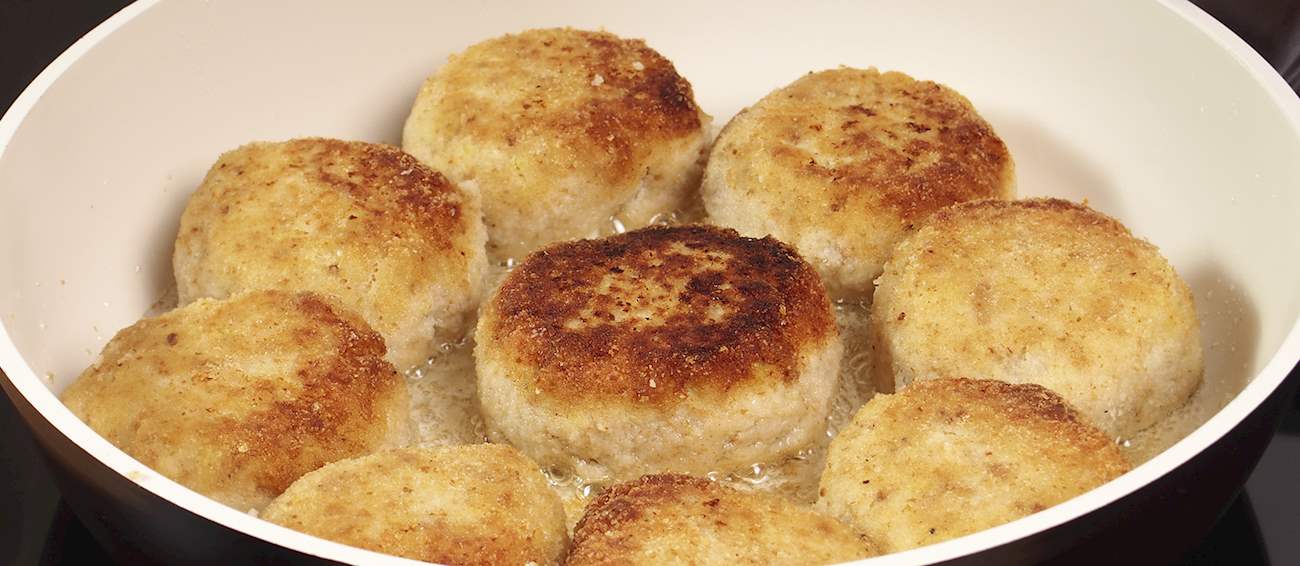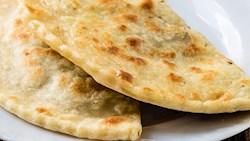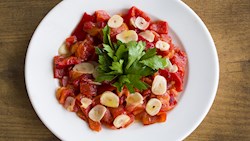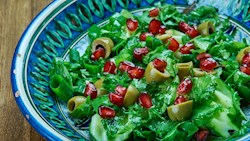Kateh is one of the easiest and simplest techniques for preparing and serving rice, preferably long-grained because it absorbs water better than most other types of rice. The rice is washed, drained, and cooked in lightly salted and oiled water.
It is cooked slowly, over low heat, allowing the rice to absorb all of the liquid. The result is not your typical fluffy rice, but a dish with a dense texture and a clean, undisguised flavor of rice. Kateh is rarely eaten on its own and is mostly served as a side dish.
Since the preparation is not complicated, it is one of the most common side dishes in Iran.
Perkedel are Indonesian fried delicacies consisting of either mashed potatoes, ground meat, ground corn, or minced fish (perkedel ikan). The name of these savory patties is derived from the Dutch word frikadel, showing the Dutch culinary influence on Indonesian territory.
Prior to frying, the main ingredient is usually combined with finely chopped scallions and pepper, then dipped in beaten eggs. Perkedel is traditionally served as an appetizer or a side dish with soto ayam soup, although it can also be consumed as a main dish, when it is usually accompanied by nasi kuning (yellow rice).
MOST ICONIC Perkedel
View moreMAIN INGREDIENTS
Pommes Anna is a minimalist, yet challenging French potato dish consisting of peeled, thinly sliced potatoes and butter. The dish is typically seasoned only with salt and pepper. The potato slices are arranged in overlapping layers, drizzled with butter, cooked on top of the stove, then baked in the oven.
When served, the baking dish is inverted, so the bottom of the casserole ends up on top. The dish was invented by a chef named Adolf Dugléré in the 19th century, who named it after one of these two actresses – either Anna Deslions or Anna Judic.
These rustic, crispy potato pancakes belong to the traditional Slovak cuisine. They consist of a thick batter made with grated potatoes, eggs, flour, and a variety of spices. Pan-fried for a short period of time until golden-brown in color, these filling snacks are usually enjoyed as the main course accompanied by various milk products, or as a side dish that is typically served alongside hearty Slovak stews.
MAIN INGREDIENTS
Llapingachos are typical Ecuadorian potato patties that are often served with a spicy peanut sauce on the side. They consist of cheese and mashed potatoes. The combination of those ingredients is flattened and cooked on a griddle until it develops a golden-brown color.
Llapingachos are traditionally served as a side dish along with avocadoes, salads, fried eggs, pork, and chorizo.
Serve with
MAIN INGREDIENTS
Kljukuša is a traditional Bosnian dish dating back to the Ottoman Empire. In its basic form, this pie-like dish is made merely with flour, salt, and water, while the filling consists of grated potatoes and eggs, and sometimes also garlic, sour cream, or milk.
The mixture is traditionally baked in round pans, and should not be too thick. When baked, kljukuša is either cut into slices or torn by hands into bite-sized pieces (ćopana or istrgana kljukuša) that are then coated in various combinations of fat, butter, sour or clotted cream, cheese, or milk.
MAIN INGREDIENTS
Käseknödel is a traditional dumpling enriched with cheese originating from Tyrol and South Tyrol. These cheese dumplings are typically served as a side dish that shows an inventive way of using leftover stale bread. The stale bread is mixed with cheese, eggs, butter, milk, onions, parsley, salt, and pepper.
Käseknödeln are usually boiled in water or fried in butter on both sides until golden brown and then served in a broth or with various salads and stews.
MAIN INGREDIENTS
Diri ak pwa, also called diri kole ak pwa, is the national dish of Haiti, consisting of rice and beans. The dish became a common, everyday staple during the period of slavery, when rice and beans were two of the few ingredients that were fed to the slaves by their owners.
It can be made with a variety of beans, but pinto, red kidney beans, and black beans are the most common options. Diri ak pwa is exceptionally nutritious as rice is rich in starch and contains iron, vitamin B, and protein, while the beans also contain iron and a greater amount of protein than rice.
MAIN INGREDIENTS
Levengi is a traditional stuffing made with walnuts, onions, and dried fruits such as raisins. The stuffing is typically additionally flavored with albukhara and alcha seasonings. It is often used in a variety of fish and poultry dishes, which are then traditionally paired with rice pilafs.
Although the stuffing is usually associated with the region of Lenkeran, it is also commonly prepared and consumed in the Shrivan and Sheki-Zagatala regions as well.
MAIN INGREDIENTS
This internationally popular, beige-colored spread is traditionally made with mashed chickpeas, tahini sesame paste, lemon juice, and garlic. People across the world love hummus for its tangy flavor and the fact that it is filled with nutrients.
When served, it is typically dressed with a drizzle of olive oil, and is then used as a dip for vegetables or a flavorful filling for flatbreads such as pita. Even today, not much is known about its origins, although the earliest mention of hummus dates back to 13th-century Egypt.
VARIATIONS OF Hummus
MOST ICONIC Hummus
View moreTasteAtlas food rankings are based on the ratings of the TasteAtlas audience, with a series of mechanisms that recognize real users and that ignore bot, nationalist or local patriotic ratings, and give additional value to the ratings of users that the system recognizes as knowledgeable. For the “Top 100 Side Dishes in the World” list until March 20, 2025, 31,821 ratings were recorded, of which 20,331 were recognized by the system as legitimate. TasteAtlas Rankings should not be seen as the final global conclusion about food. Their purpose is to promote excellent local foods, instill pride in traditional dishes, and arouse curiosity about dishes you haven’t tried.




































































































































